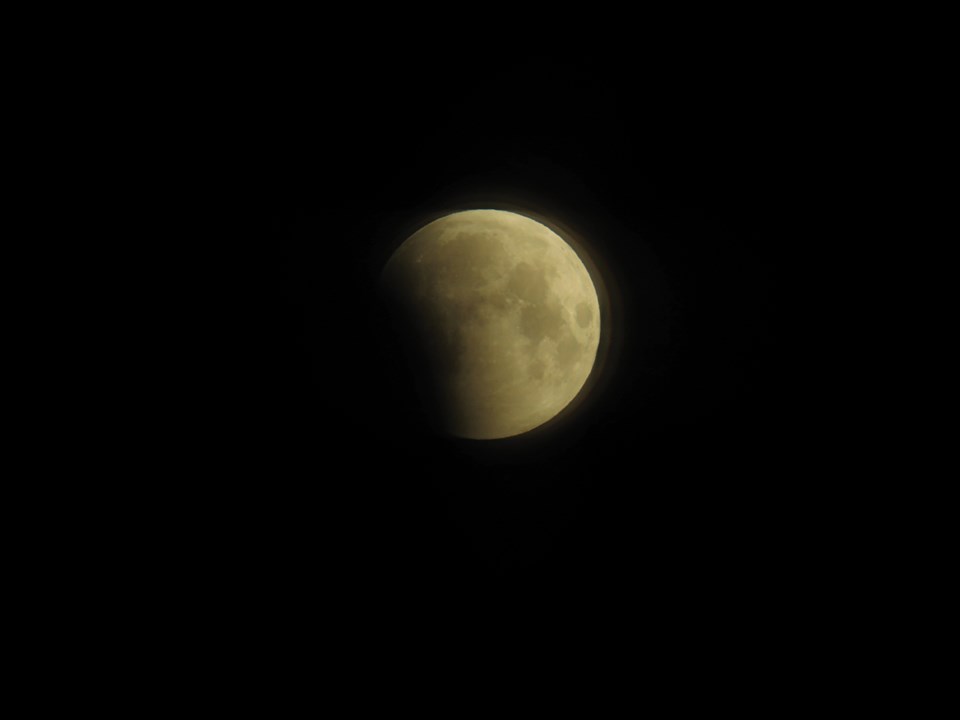This month’s article is being submitted on May 25 in time for the May 28 issue, the last Friday of the month. Accordingly, there’s nothing to be said about the lunar eclipse which will occur in the wee hours on May 26. I expect however reports and photos on many sites by Friday; check sunshinecoastastronomy.wordpress.com and the Astronomy Picture of the Day site (APOD) at: apod.nasa.gov/apod/astropix.html. This site has today a time-lapse video of the eclipse of Jan. 31, 2018. There may be similar photos/video later of the May 26 event.
Venus is visible all month in the WNW just after sunset; it’s moving to the left/east from behind the Sun so its elongation (angular separation) from the Sun increases all month. Unfortunately for those of us north of the equator, the ecliptic east of the Sun slopes slightly down towards the celestial equator and although Venus gets farther east of the Sun, it won’t get any higher in the sky. After about 10 p.m. on June 11, a very thin New Moon will be about 1 degree to the right of Venus, very low in the WNW, less than 5 degrees above the horizon. The next evening, the waxing moon will be about halfway between the Moon and Mars.
Later in the month, Mars passes through the Beehive Cluster, aka Messier 44, an open cluster of stars easily visible with binoculars. Mars will pass from lower right through to the upper left on the nights of June 22 through 24. Having a fixed set of background stars makes it very clear just how quickly the planets move through the sky.
At 7 p.m. June 11, online on Zoom, the Sunshine Coast Centre of the RASC presents the Explore the Universe Challenge. Sunshine Coast member Charles Ennis will introduce the RASC’s Explore the Universe Program and teach viewers how to find the objects in the summer viewing portion of the program. Later this year Charles will come back on Zoom to teach the fall and winter segments. Details and sign-on info will be available at: sunshinecoastastronomy.wordpress.com.
One of the topics in Charles’ lecture will no doubt be the Summer Triangle – three prominent stars visible in the summer and fall skies. To whet people’s appetites for this talk, let’s look at some facts about these three stars:
Deneb, the star in the tail of Cygnus the Swan, is about 2,500 light-years (ly) away. Even so, it is still one of the brightest stars we can see in the sky. It began its early life as an O type main sequence star of about 23 solar masses, but has now exhausted the hydrogen in its core and expanded to a blue supergiant diameter perhaps 200 times that of the Sun, about the radius of Earth’s orbit, with a luminosity perhaps 200,000 times that of the Sun. Be very, very happy we’re 2500 ly away from this monster; when it goes supernova, it will likely be as bright as a full Moon.
Vega is the bright star in Lyra and is 25 ly distant and much more civilized. Compared to our Sun, it has twice the mass, 2-1/2 times the diameter and 40 times the luminosity. It is roughly half a billion years old (one-tenth the Sun) and will live about the same before it blows off most of its atmosphere and becomes a white dwarf. Oddly, Vega rotates very quickly – every 12.5 hours (our Sun takes 25 days). As a result, its rotational velocity at its equator is about 88 per cent of its orbital velocity and its equatorial diameter is about 20 per cent greater than its polar diameter. This results in some weird physics inside the star. We also appear to be to viewing Vega nearly pole-on.
Altair is about 17 ly away in the constellation of Aquila the Eagle. Its name is Arabic and, according to my fluent stepson-in-law, is “al ta-eer,” with each vowel in the back pronounced separately and meaning “the flying one.” Coincidentally, it is like a smaller Vega; compared to our Sun, it has 1.7 times the mass, 1.6 times the diameter and 10 times the luminosity. It also rotates very quickly – every nine hours or so – and is also egg-shaped.
These three stars are only markers in the sky, however. There are many more things to see in our summer skies with naked eye, binoculars and telescopes and Charles Ennis’ presentation on June 11 will cover the best of them. It is certainly the best introduction to visual astronomy I’ve ever seen; you don’t want to miss it!



